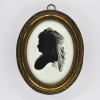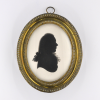Lightfoot, Mary, Mrs
Introduction:
Like her daughter, also christened Mary, Mrs. Mary Lightfoot painted bust-sized works on plaster, housed in pressed brass frames. On her 2 known trade labels, she uses the honorific Mrs. Lightfoot, while her daughter describes herself as "M. Lightfoot"on her single printed trade label.
Arguably unfairly, McKechnie describes their work as "coarse". Both however appear competent artists, though admittedly neither mastered a high degree of delicacy painting embellishments outside the main body of their profiles. It's also generally accepted Mrs. Lightfoot's skills were a degree superior to her daughter's.
Mrs.Lightfoot is perhaps best remembered for the fact that the already highly successful profilist John Miers (1758-1821) lodged under her roof in Liverpool's Castle Street betwen June 1785 and January 1786. This led to a controversy between Miers and Mrs. Lightfoot's daughter, which spilled into print on the front pages of 2 editions of the CALEDONIAN MERCURY in Octrober 1786.
In brief, it's certain the Lightfoots acquired several of Miers' works, occasionally perhaps in lieu of bed and board. They certainly observed his working methods and financial success and he may well have mentioned future travel plans. It's certain Miers received a considerable shock when, arriving in Edinburgh in October 1786, he found 16-year-old Miss Lightfoot operating as a profilist displaying in several shops examples of HIS and her works under HER own name. In a lengthy advertisement in the CALEDONIAN MERCURY on the 18th of October, he described how, in Liverpool, Miss Lightfoot "...clandestinely picked up his art". He then effectively put her out of business by visiting every shop where she displayed her work, placing his alongside for comparison.
Miers makes no mention of Mrs.Lightfoot, but it's conceivable she chaperoned her 16-year-old daughter to Scotland. Supporting the supposition is the fact Miss Lightfoot, as evidenced by her July 1799 marriage record, was illiterate. Her mother was not, and a degree of literacy was surely required to place newspaper advertisements and deal with business matters in general.
It's possible the Lightfoots turned to what must have appeared to them to be the profitable art of profile taking, as their Castle Street abode was very likely demolished in April 1786. Liverpool in the Last Quarter of the 18th Century 1775-1800 describes Castle Street, though one of the city's principal streets, as narrow and difficult for traffic to negotiate. In April 1786, 3 months after Miers' departure, all properties on the west side and part of the east side were demolished for road-widening.
By late summer 1786, it's probable both Lightfoots were painting likenesses professionally. As recorded in the CALEDONIAN MERCURY on the 18th of September, Miss Lightfoot was certainly in Glasgow that month before moving on to her confrontation with Miers in Edinburgh the following month. As far as known, the next and last recorded advertisements from Mrs. Lightfoot's daughter were placed in the BATH CHRONICLE on the 1st of November and 13th of December 1787.
With no specific newspaper advertisements or recorded handbills, the extent of Mrs. Lightfoot's career is difficult to assess. No conclusive evidence has been discovered to show her working outside Liverpool. McKechnie mentions an undated Limerick address on the rear of a work, but with no evidence that Mrs. Lightfoot travelled there, the address may well belong to the sitter. That she was still in practice in 1792 is assumed from a dated profile of a member of the Doran family of Liverpool. From the number of Lightfoot profiles she examined, McKechnie was confident all, in terms of dress, date from ca.1786 to the early 1790s.
A year after Miss Lightfoot's debacle with Miers, "M. Lightfoot" placed 2 advertisements in the BATH CHRONICLE in November and December 1787. If Mrs. Lightfoot, for reasons already stated, accompanied her daughter to Edinburgh, it's probable they also travelled together to Bath.
Bolstering this assumption is a named work illustrated by McKechnie of the Somerset-based Revd. James Rouquet (1762-1837), who married in Bath on the 31st of October, the day before "M. Lightfoot's" advertisement was placed. Though the profile lacks a trade label, McKechnie is certain that it can be ascribed to Mrs. Lightfoot, so it appears plausible mother and daughter may have worked in tandem.
A Correction - Regarding Mrs. Lightfoot's background, McKechnie tentatively suggested either Mrs. or Miss Lightfoot appeared in 1790s Liverpool directories and in later editions as a "Victualler". The assumption is an error. Dying unmarried aged 84 in 1837, "Mary Lightfoot-Victualler" was the daughter of Eleanor and Bernard Lightfoot, Brewer, Ironmonger and Overseer of Liverpool's St. Nicholas Parish.
In fact extensive research in 2022 discovered the only mother/daughter combination to fit the timeframe were Mary Lightfoot, née Lightbound (1744-1814), who married Thomas Lightfoot (1742-1818), a Liverpool-based Master Mariner, in August 1767. Their daughter Mary (1770-1856) was their eldest daughter and 3rd of 9 children born between 1768-1784.
Often appearing in the LIVERPOOL MERCURY shipping news from the 1770s onwards, Mrs. Lightfoot's husband Thomas captained transatlantic merchant ships. Three sons also became Ship's Masters, while a fourth traded as a Sailmaker, so it's not surprising that, from the late 1780s, Lightfoot abodes are recorded in Park Lane, a street well-known for its maritime connections.
The St.Thomas burial register records Mrs. Mary Lightfoot of Park Lane, aged "70 yrs", was buried on the 25th of September 1814. Her daughter Mary married neighbour John Payne (1772-1841), a painter, plumber and glazier of Park Lane in July 1799. She was interred in the same burial ground in 1856, aged 86.
Revised 29 September 2022 (Brian Wellings)
Additional research about Mrs Mary Lightfoot:
Source: McKechnie (Author of, British Silhouette Artists and their Work 1760-1860)
Lightfoot, Mary, Mrs (McKechnie Section 4)Source: Joll (Hon. Secretary of the Silhouette Collectors Club and Editor of the Club's newsletter)
Lightfoot, Mary, Mrs (SCC Newsletter December 2001)

